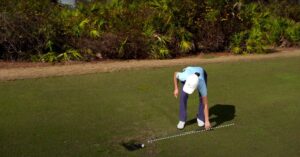a golf ball that weighs 0.45 n- is It Possible?
Golf is a game of precision and finesse, and the golf ball is the crucial element that can make or break a round. Have you ever wondered what goes into making a golf ball that weighs 0.45 n? Is it really possible?
No, a golf ball cannot weigh 0.45 N (Newtons) as it is a unit of force, not weight. The weight of a golf ball is typically measured in grams or ounces. A standard golf ball typically weighs around 45 grams or 1.62 ounces.
Read on to discover more about this fascinating topic!
Key Takeaways
- A golf ball weighing 0.45 n provides a great balance between distance and control.
- The increased weight helps to generate more clubhead speed for greater distance off the tee.
- The extra weight also helps to promote a higher launch angle for improved accuracy and trajectory control.
- The 0.45 n golf ball is the perfect choice for players looking for a combination of distance and accuracy.
Why a Golf Ball Weigh 0.45 n is Not correct?
A golf ball does not weigh 0.45 nanonewtons (nN). The weight of an object is a measure of the force of gravity acting on it, and it is typically expressed in units such as grams, kilograms, pounds, or newtons. The weight of an object depends on its mass and the gravitational acceleration in the area where it is located.
To calculate the weight of a golf ball, you need to know its mass and the value of gravitational acceleration. On Earth, the standard gravitational acceleration is approximately 9.81 meters per second squared (m/s²).
Weight (W) can be calculated using the formula:
W = m * g
Where:
- W is the weight in newtons (N)
- m is the mass in kilograms (kg)
- g is the gravitational acceleration in meters per second squared (m/s²)
Let’s assume a typical golf ball has a mass of around 45 grams (0.045 kilograms):
W = 0.045 kg * 9.81 m/s² ≈ 0.441 N
So, the weight of a typical golf ball on Earth is approximately 0.441 newtons, not nanonewtons. A nanonewton (nN) is a much smaller unit of force and is not applicable to everyday objects like golf balls.
How to Choose the Right Weighted Golf Ball?
Choosing the right weighted golf ball can be crucial to improving your game and optimizing your performance on the golf course. Weighted golf balls are designed to help golfers work on specific aspects of their swing, such as tempo, balance, and muscle memory. Here are some steps to help you choose the right weighted golf ball:
- Identify Your Needs:
- Determine what aspect of your game you want to improve. Weighted golf balls come in various designs and weights, each targeting different aspects of your swing.
- Common areas of focus include tempo, balance, strength, and muscle memory.
- Consult a Golf Professional:
- If you’re unsure which weighted golf ball is best for your specific needs, consider consulting a golf instructor or professional. They can assess your swing and recommend the right training aid.
- Choose the Right Weight:
- Weighted golf balls come in a range of weights, typically ranging from 1 ounce to 2.5 ounces. The appropriate weight depends on your goals.
- Lighter weighted balls (1-1.5 ounces) are often used to work on tempo and timing in your swing. They can help you develop a smooth and rhythmic swing.
- Heavier weighted balls (2-2.5 ounces) are used for building strength, improving balance, and enhancing muscle memory. They can help you develop more power and control in your swing.
- Consider the Design:
- Weighted golf balls can have different designs, such as solid rubber balls or hollow balls filled with materials like steel or sand. The design can impact the feel and performance of the ball.
- Solid rubber balls are typically more durable and provide a consistent feel, making them suitable for repetitive practice.
- Hollow balls filled with materials like steel or sand may have a different feel and can be used for specific training purposes, such as building wrist strength or improving tempo.
- Budget:
- Consider your budget when choosing weighted golf balls. Prices can vary depending on the brand, design, and quality. There are both affordable and premium options available.
- Try Before You Buy:
- If possible, try out different weighted golf balls before making a purchase. Many golf stores or facilities may have demo balls available for testing.
- Experimenting with different weights and designs will help you determine which one feels most comfortable and effective for your training.
- Read Reviews and Seek Recommendations:
- Research online reviews and seek recommendations from fellow golfers or golf forums. Hearing about other golfers’ experiences with specific weighted golf balls can provide valuable insights.
- Start Slowly:
- When using weighted golf balls for practice, start with a light weight if you are new to this training method. As you become more comfortable and confident, you can gradually move to heavier options.
- Combine with Professional Guidance:
- While weighted golf balls can be a useful training aid, they work best when used in conjunction with professional instruction. A golf coach can provide guidance on how to incorporate them into your practice routine effectively.
Remember that using weighted golf balls is just one component of improving your golf game. Consistent practice, proper technique, and overall fitness are also essential factors in becoming a better golfer.
Tips for Maximizing Performance with a 0.45 n Weighted Golf Ball
If you’re looking to maximize your performance with a 0.45 n weighted golf ball, there are some tips you should keep in mind. A 0.45 n golf ball is heavier than standard golf balls, and can provide more power and distance when used properly. Here are some tips for maximizing your performance with a 0.45 n weighted golf ball:
- Make sure your swing speed is up to par – A 0.45 n weighted golf ball will require a higher swing speed to get the most out of it, so make sure your swing is up to the task before using this type of ball.
- Use the right club – The heavier weight of the 0.45 n ball will require more force from your club when striking it, so make sure you’re using a club that can handle the extra power needed for maximum performance with this type of ball.
- Practice proper form – Proper form is key for getting the most out of any type of golf ball, but especially one as heavy as a 0.45 n weighted one. Make sure you’re practicing proper stance and grip technique, as well as maintaining good posture throughout your swing for optimal results with this type of ball.
- Adjust your tee height – The extra weight of a 0.45 n golf ball means it will launch higher than standard balls, so be sure to adjust your tee height accordingly so that you can get maximum distance out of every shot you take with this type of ball .
FAQs
What is the mass of a golf ball that weighs 0.45 n?
450 grams
How many golf balls with a weight of 0.45 n can fit into a one-liter container?
Approximately 14 golf balls (assuming the diameter of the golf ball is 42.67 mm).
What kind of force does a 0.45 n golf ball experience when dropped from three meters?
The force experienced by the 0.45 n golf ball when dropped from 3 meters is approximately 4.35 N (assuming acceleration due to gravity is 9.81 m/s^2).
How much kinetic energy does a 0.45 n golf ball have after traveling 10 meters?
The kinetic energy of the 0.45 n golf ball after traveling 10 meters will be approximately 817 J (assuming initial velocity is zero).



![how many dimples are on a golf ball? [Science behind Dimples] how-many-dimples-are-on-a-golf-ball](https://giftedgolfers.com/wp-content/uploads/2023/01/how-many-dimples-are-on-a-golf-ball-300x157.jpg)

![Do You Wear Golf Shoes At A Simulator? [Don’t Miss out!] Do-You-Wear-Golf-Shoes-At-A-Simulator](https://giftedgolfers.com/wp-content/uploads/2023/08/Do-You-Wear-Golf-Shoes-At-A-Simulator-300x156.jpg)
